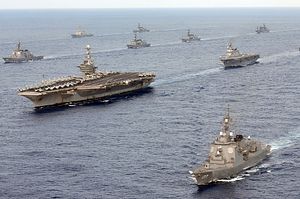On June 9, a Chinese People’s Liberation Army Navy (PLAN) frigate sailed near Senkaku Island. Although the naval vessel stayed in the contiguous zone, and therefore did not enter Japan’s territorial waters, this is the first time that a PLAN vessel came this close to the Senkakus, which are also claimed by China (where they are called the Diaoyus). The incident came only a few days after a Chinese J-10 fighter jet resorted to risky maneuvers, flying too close to intercept a U.S. RC-135 surveillance aircraft that was flying over the East China Sea on a routine surveillance flight.
Japan’s government reacted strongly. Prime Minister Shinzo Abe immediately directed his government to continue to monitor the situation closely, maintain close contact with the United States, and be prepared for any unexpected turn of the events. Defense Minister Gen Nakatani, on his way home from his visit to Myanmar, Thailand, and Timor-Leste following his attendance at the Shangri-La Dialogue, expressed his grave concern over China’s behavior. The Japanese foreign minister summoned China’s ambassador to express the government’s serious concern and protests.
One can only speculate the motives behind this sudden spike in assertive behavior by the Chinese PLA in East China Sea. Most probably the driver is the diplomatic isolation Beijing faced at the Shangri-La Dialogue over the last weekend. During the conference, China found itself encircled by countries that directly and indirectly criticized China’s behavior in the South China Sea. U.S. Secretary of Defense Ashton Carter called for a “principled security network” in the region that upholds international norms, in addition to calling out China for its behavior more than a dozen times. Japan’s own Nakatani outlined in detail Japan’s concern with “unilateral” behavior in the East and South China Seas.
And it was not just the United States and Japan. Indian Defense Minister Manohar Parrikar discussed his country’s firm determination to “uphold freedom of navigation and/or flight in accordance with international law.” French Defense Minister Jean-Yves Le Drian emphasized the importance of a rule-based order and reaffirmed that France would continue to send its ships and aircrafts “wherever international allows and operations require.”
Put simply, the critical views vis-à-vis China in the South China Sea are growing beyond the Asia-Pacific region. In addition, the ruling on the case brought by the Philippines to the Permanent Court of Arbitration looms. Given these developments, China may have felt compelled to assert its position in the East China Sea, thereby also trying to distract attention away from the South China Sea.
There is no question that China is testing the resolve of Japan and the United States with its heightened activities in the East China Sea. Against Tokyo, Beijing is pushing the envelope to see if their activities would trigger a Japanese overreaction, which China then can use as a reason to justify its enhanced activities in the East China Sea. Vis-à-vis the United States, it is testing Washington’s will to uphold its defense commitment toward Japan.
The United States and Japan can counter these moves by doing a few things. First, they should continue to conduct and even expand the opportunities for joint exercises with other partners in the region to demonstrate the strength of the security partnership that upholds international norms and principles, including freedom of navigation. The trilateral exercises between the United States, Japan, and Australia including Southern Jackaroo (completed last month) and the U.S.-Japan-India trilateral exercise Malabar (which began June 10 off the coast of Okinawa) are excellent examples. By conducting these trilateral exercises, the U.S. and Japan together send the message that Beijing is up against a group of countries that are opposed to its approach to territorial disputes.
Secondly, Japan should intensify its efforts to counter Chinese military maneuvers in the vicinity of its territory by ensuring that Chinese ships and/or aircraft will be met by Japanese vessels and jets every time they get too close to Japanese territory. Japan has been doing this all along when it comes to airspace. The recent behavior by the PLAN can be a blessing in disguise, as it now provides a justification for Japan to increase the activities by the Japan Self Defense Forces in the name of intelligence gathering and monitoring. By doing so, Tokyo can send an unambiguous message to Beijing that the Japanese government does not tolerate the unilateral move to change the status quo.
Finally, the United States must continue its reassurance to allies in the region that Washington will stay engaged and be supportive of the countries that try to settle these disagreements peacefully through diplomacy. Whether it is called the “rebalance to Asia” or a “principled security network,” U.S. allies and partners need to know that the United States will stay engaged in the region, and be supportive of their response to China’s unreasonably risky behavior. Washington can provide such assurance by using all elements of national power, from calling out Chinese misbehavior in public forums, as Carter did, to more coordinated assistance in Southeast Asia, which can contribute to capacity-building efforts throughout Asia.
Chinese behaviors in the East China Sea over the last week pose a difficult challenge to both the United States and Japan. Their response needs to be strong and coordinated to demonstrate they are unified in their unwillingness to bend to China’s assertion, while these responses need to be carried out in such a way that China cannot point it finger at either of them as the reason for rising tensions. In order to strike this fine balance, close consultation will be more critical than ever. Given both Tokyo and Washington are in a political season, China’s behavior in the East and South China Seas for the next several months may be an important test of the resilience of the coordination mechanism within the U.S.-Japan alliance, which both sides have spent the last several years strengthening.

































